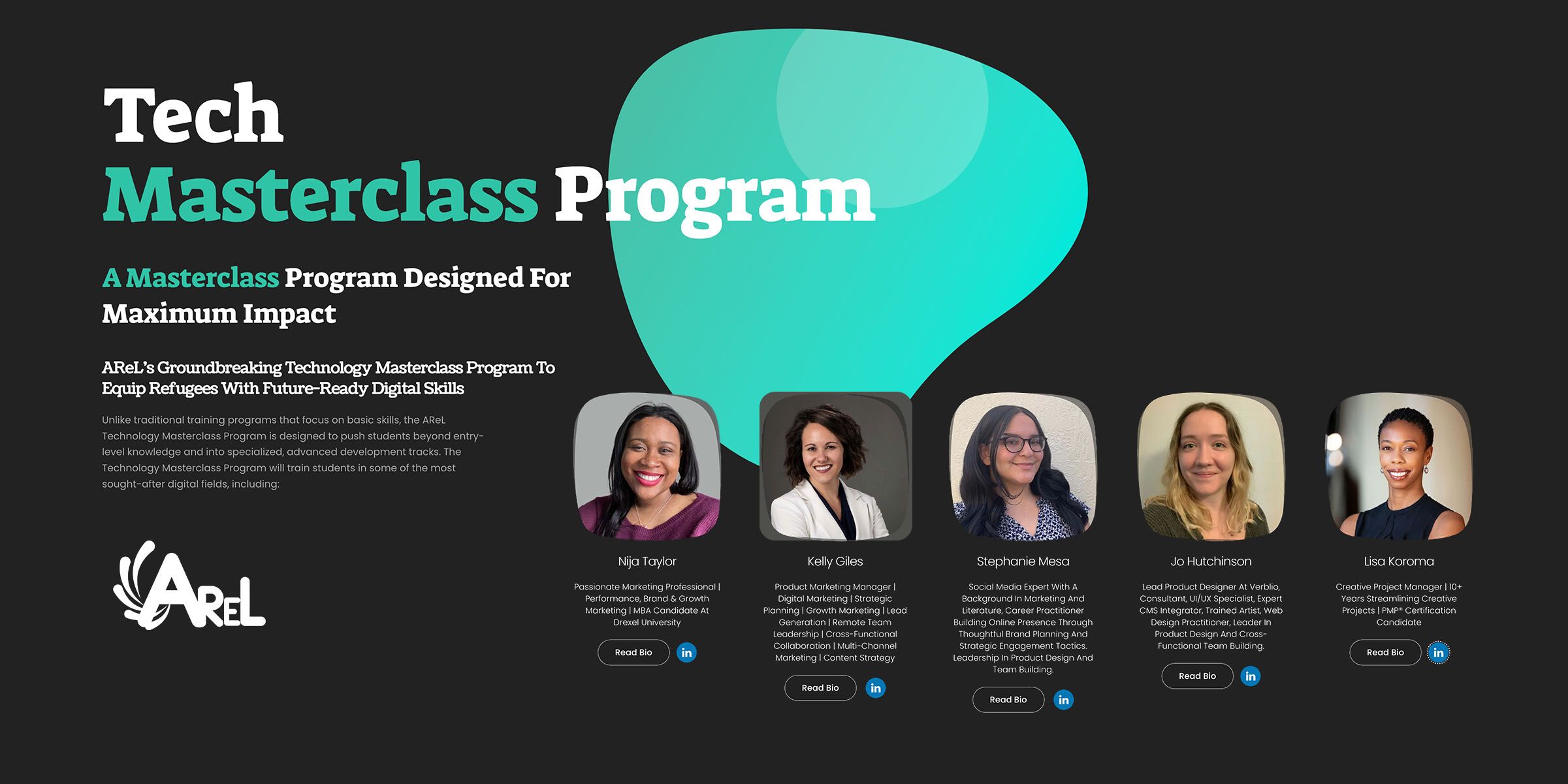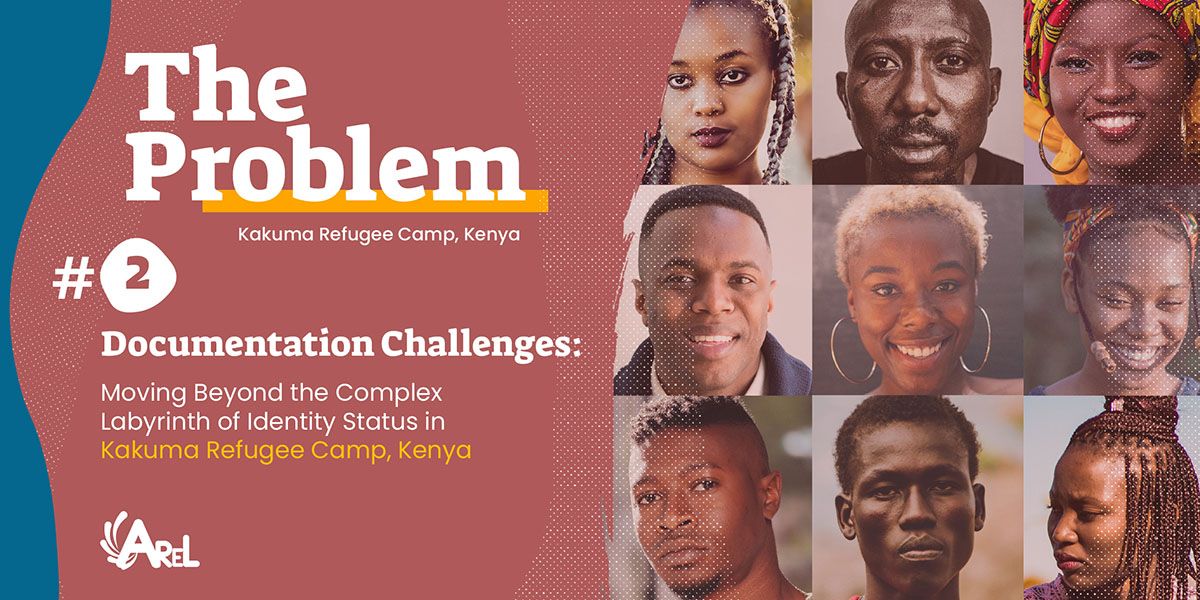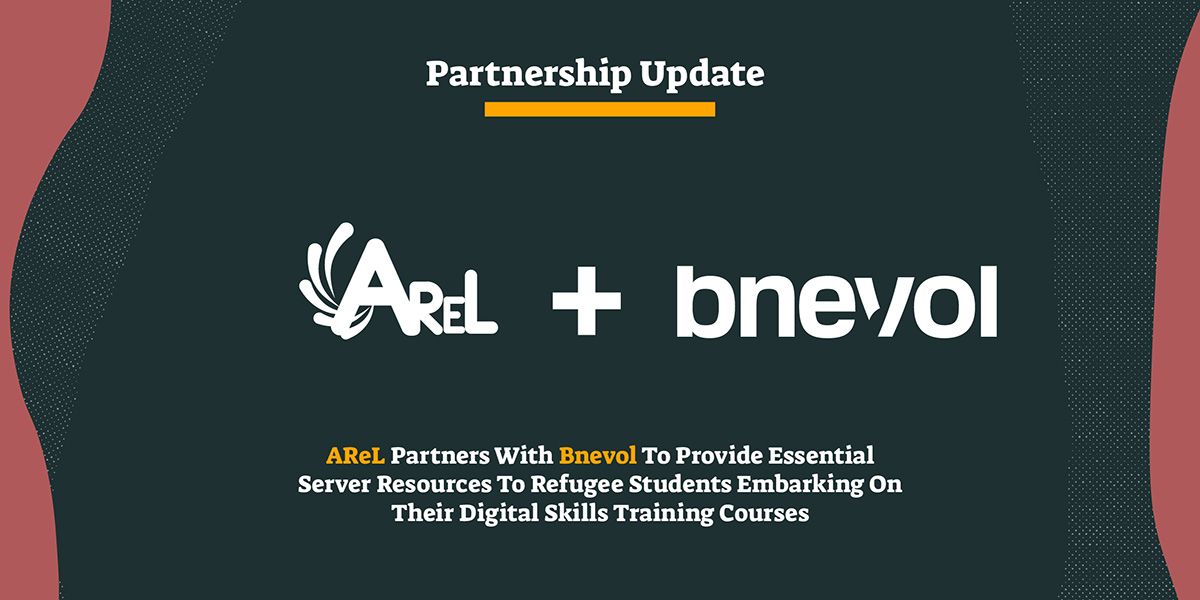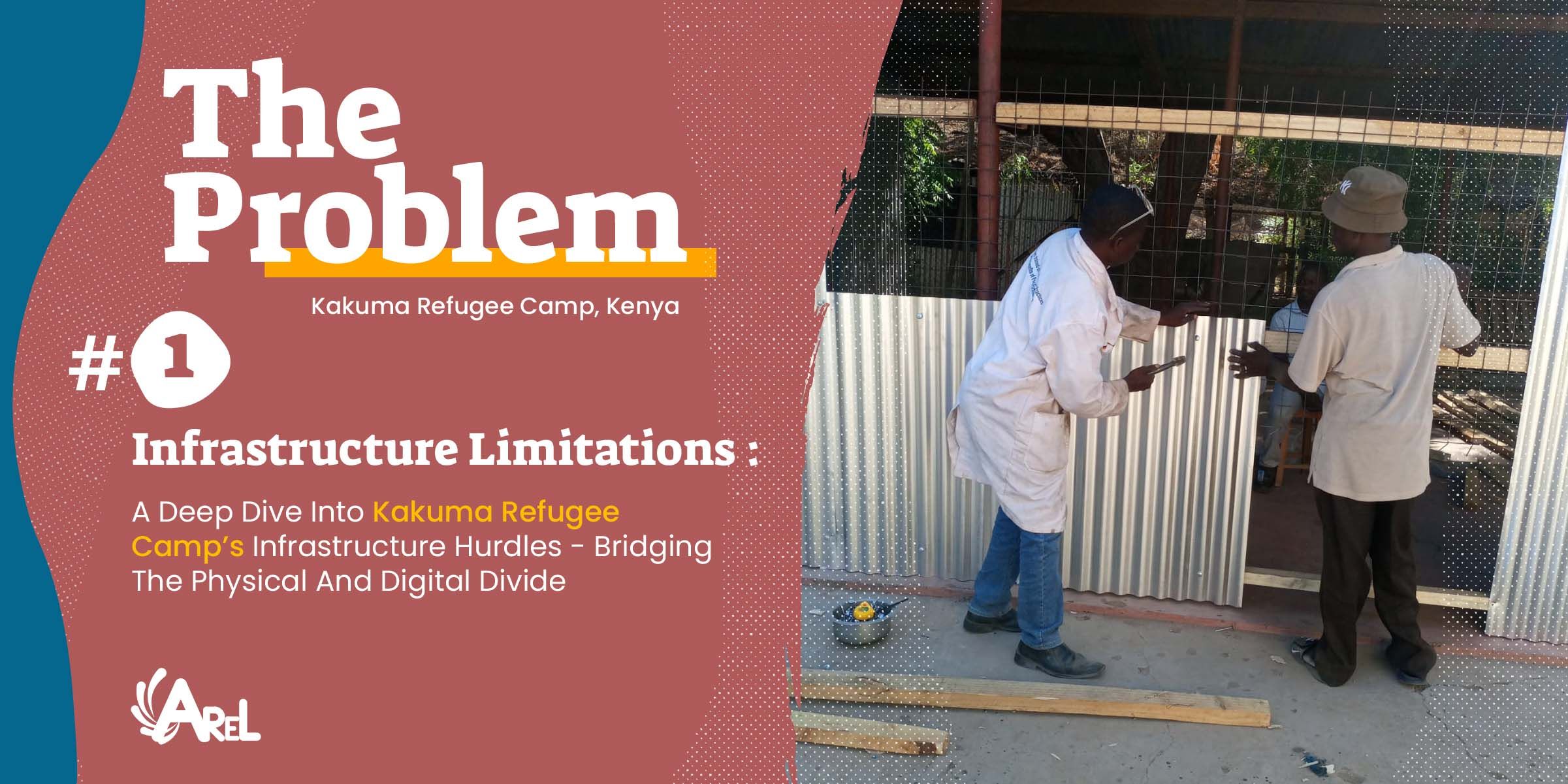
Author
AReL

The Problem - Part One: Infrastructure Limitations in Kakuma Refugee Camp
A Deep Dive Into Kakuma's Infrastructure Hurdles - Bridging The Physical And Digital Divide
The Kakuma refugee camp, nestled far from the hustle and bustle of Nairobi, stands as a testament to the resilience of its inhabitants. Here, thousands of refugees from various nations seek refuge, dreaming of a brighter, more secure future. While these dreams are universal, the challenges the camp's residents face are unique and often exacerbated by its remote location.
Enter Action for Refugee Life (AReL). Founded in the heart of this camp in 2022, AReL is more than just an organization; it's a beacon of hope. Driven by the belief that every refugee deserves a shot at a sustainable and self-reliant future, AReL offers a bridge over the gaping chasm of challenges. From providing the necessary tools and resources to mentorship and post-graduation support, AReL is determined to empower the community at every step.
Yet, amidst all the aspirations, there lies a hurdle that's often overlooked but is foundational to most modern initiatives: infrastructure. The physical distance of Kakuma from Nairobi isn't just a geographic fact; it translates into very tangible infrastructure limitations that hamper various growth initiatives, notably in the digital domain. This series seeks to shed light on these challenges, delve into their implications, and explore potential solutions.
1. The Geographic Challenge: Distance From Nairobi
2. Connectivity Concerns: Internet Stability And Its Implications
3. Physical Infrastructure: Learning Environments And Shelter Concerns
4. Digital Infrastructure: Inadequate Computing Resources
5. The Road Ahead: Possible Solutions And AReL's Vision
1. The Geographic Challenge: Distance from Nairobi
At first glance, the distance from Nairobi seems like a logistical challenge, a matter of mere miles. However, the implications of this geographic separation run deep, directly influencing the pace and quality of infrastructure development in the Kakuma refugee camp.
The most immediate concern that arises from this remoteness is the essential availability of resources. Getting materials, technology, and skilled personnel to a location far removed from the country's primary urban centers is challenging and costly.
|
A report by the World Bank highlighted that logistic costs, which include transportation, can account for up to 50-75% of the retail price of goods in some African countries. |
This heightened cost underscores the difficulty of setting up vital infrastructure in places like Kakuma.
But the challenge isn't solely about physical distance but also environmental hardships. Regular flooding is a recurring issue in the region. UNHCR reported in 2020 that Kakuma experienced heavy rainfall, affecting more than 10,000 refugees, prompting relocations due to the destruction of their shelters. Properly planned drainage systems and robust buildings could significantly mitigate these effects. Yet, with the African Development Bank estimating a financing gap of $68–$108 billion for Africa's infrastructure needs, the challenge of garnering adequate resources becomes even steeper.
|
The African Development Bank estimates a financing gap of $68–$108 billion for Africa's infrastructure needs. |
Moreover, these environmental challenges aren't mere acts of nature but intertwined with infrastructure. Properly planned drainage systems, robust buildings, and elevated roadways could significantly mitigate the effects of these floods. Yet, the geographic distance compounds the difficulty of implementing such solutions. The isolation means fewer experts on the ground, limited resources, and prolonged response times to crises.
Lastly, the distance from Nairobi has intangible effects too. Being far from the nation's capital and primary business hubs can sometimes translate into being 'out of sight, out of mind.' The dire need for development and resources in distant areas like Kakuma can often be overshadowed by more immediate concerns in urban centers, leading to delays in policy decisions, fund allocations, and project implementations.
In essence, while Kakuma's geographic challenge might seem like a simple hurdle of distance, its cascading effects on infrastructure development, environmental planning, and the overall well-being of the residents are profound and far-reaching.
2. The Case for Connectivity, the New Human Right - Connectivity Concerns, Internet Stability, and its Implications
As the United Nations decrees, the case for connectivity is the new human right. In today's digital era, where almost every facet of life – education, work, or communication – is intrinsically linked to the internet and mobile devices, having a stable connection is not just a luxury but a necessity. While it's commendable that mobile phone access in Kakuma is notably high, the nature of this access presents its challenges.
|
Of those with mobile phones, 44% owned a smartphone, 15% owned a feature phone, and 39% owned a basic phone, according to Elrha. |
However, many are relegated to a mere 2G connectivity, experiencing average speeds of just 1.5 mbs.
The vast prevalence of mobile phones in the camp, particularly smartphones, means that many refugees possess the tools to connect. Yet, the limited internet speeds and outdated 2G connectivity hinder their potential to harness the full capabilities of these devices. It's not merely about accessing the internet; it's about the quality of that access.
Infrastructure constraints further expose limitations when connected laptops aim to facilitate learning. Imagine a classroom with eager students poised to delve into a new lesson. The screen flickers to life and the teacher's voice is about to chime in, but then – a pause, a glitch, and a prolonged silence. If such occurrences become routine and expected, it disrupts the flow of knowledge and the incentive to engage in learning. The need for robust internet connectivity isn't merely about bandwidth; it's about ensuring that multiple classroom student refugees can connect simultaneously without facing lags, ensuring that knowledge delivery, especially on connected devices, is efficient and effective.
The ramifications of inconsistent internet and mobile access reach far beyond academic disruptions. A stable and reliable internet connection is a lifeline to the outside world, offering opportunities for refugees to interact, learn, and even seek employment opportunities beyond the confines of the camp. It's about bridging the gap between Kakuma and the global community, enabling refugees to participate actively in the digital age using their phones.
With its commitment to fostering education and self-reliance within the refugee community, AReL has firsthand felt the weight of these connectivity challenges. Every glitch, every dropped connection, isn't just a technical hiccup; it's a disruption in a student's journey striving for a brighter future. Such issues underscore the importance of mobile-optimized digital lessons and the broader vision of AReL to bridge the digital divide. To truly realize the potential of every refugee, the foundation of stable internet connectivity needs to be laid. And while AReL has innovated ways to improve the delivery of connected lessons, much more must be done to introduce durable solutions at scale.
Internet stability and robust connectivity are paramount in AReL's comprehensive programs, from digital training courses to mentorship and job placement. Without it, the bridge between enrollment and employment – a journey that involves various digital touchpoints, from online courses to virtual meetings with potential employers – gets fragmented.
While Kakuma's connectivity concerns seem technical, they are, in essence, deeply human. They're about aspirations, opportunities, and the basic human desire to connect, learn, and grow through various means. Addressing these concerns is not just about installing better routers or increasing bandwidth; it's about laying down the digital infrastructure that can truly unlock the potential of Kakuma's residents.
3. Physical Infrastructure: Learning Environments, Shelter, and More
Kakuma refugee camp, established years ago and backed by myriad organizations working tirelessly to uplift its residents, grapples with pressing physical infrastructure challenges. These challenges encompass the rudimentary infrastructures that support daily life and facilities crucial for education, health, safety, and recreation.
A stroll through Kakuma unveils the raw state of its infrastructure. Makeshift tents, sporadic power sources, and buildings crafted from local materials are commonplace. While the indomitable spirit of its inhabitants is evident, the infrastructure supporting them often falters under duress.
For education to genuinely thrive, classrooms require more than mere walls. They demand environments fostering conducive learning, with sturdy tables, comfortable seating, efficient lighting, electronic devices for global connectivity, and consistent electricity. These can lead to compromised learning experiences and can also pose daily challenges. For instance, a student desiring to study after sunset might need more lighting. At the same time, another keen on attending a virtual class might face hurdles like no seating or an unstable power supply. Each missing infrastructure component isn't just an item in deficit; it symbolizes a potential obstacle for a refugee yearning for a brighter tomorrow.
The educational facilities typically need more digital and technical infrastructure for modern skills development for young Africans preparing to enter the global workforce. Regrettably, a significant fraction of the population has never attended school, particularly women, hindering the growth of a skilled local workforce.
|
According to a UN-Habitat survey for Turkana West Sub-county, 69% had never been to school. |
In Kakuma-Kalobeyei, 33% of respondents surveyed by UNHCR have not received formal education, with women accounting for 69% of those without formal education.
While we focus the infrastructure problem around education, it extends beyond. The health facilities in Kakuma play a pivotal role. Most residents depend on NGO-run health establishments. However, they often need more adequately stocked dispensaries and prolonged waits for primary health care. Recreational facilities are sparse but essential for residents' well-being and holistic development.
While the resolve of Kakuma's denizens remains unshaken, the existing physical infrastructure often needs to be improved. Building a robust foundation is not merely about erecting structures but creating a space where dreams can soar, undeterred by present constraints.
4. Digital Infrastructure: Inadequate Computing Resources
In the 21st century, the computer has evolved from a luxury to an absolute necessity, especially in education and work. It's a window to a universe of information, a tool that simplifies complex tasks, and a platform that brings distant people closer. However, in Kakuma, this essential tool is in short supply, and the implications of this shortfall touch every corner of life within the camp.
To truly understand the gravity of the situation, one must first recognize computers' indispensable role in today's educational landscape. Modern pedagogy leans heavily on digital resources – interactive lessons, research, simulations, and e-books, to name a few. Beyond education, computers pave the way for diverse work opportunities, allowing individuals to break geographical barriers and tap into the global job market.
Yet, acquiring and maintaining computers in Kakuma is laden with obstacles. For many refugees, purchasing a computer remains a distant dream, given the financial constraints. Even when computers enter the camp, the harsh environmental conditions and limited maintenance expertise often mean these machines have shortened lifespans.
However, one of the most poignant challenges arises when well-intentioned donations land in Kakuma. While every laptop donated represents a beacon of hope, the limited numbers they often come in present a heart-wrenching dilemma: Who gets the golden ticket? When laptops arrive in batches of dozens rather than in the hundreds or thousands that are genuinely needed, organizations like AReL find themselves on the horns of a dilemma. These aren't just devices but potential gateways to a better life. Deciding who gets access becomes a logistical challenge and a moral one. It's a situation where gratitude for generosity meets the pain of disparity.
The heart of the matter isn't just about having a device to work or study; it's about equity. Small batches mean that while some refugees get to stride forward, equipped with digital tools, others may watch from the sidelines, their aspirations momentarily paused. Such disparities, even if unintentional, can sow seeds of discontent within the community.
Organizations like AReL are considering thoughtful and adaptive solutions, from setting up communal computer centers to rotating access, ensuring that as many individuals as possible can benefit. But the underlying challenge remains – until every refugee has personal, unhindered access to computing resources, the journey toward comprehensive digital empowerment remains incomplete.
The lack of adequate computing resources is a tangible reminder of the road yet to be traveled. It's a journey that requires collective effort, empathy, and a deep understanding of the transformative power of technology.
The Road Ahead: Possible Solutions and AReL's Vision
The challenges of infrastructure in Kakuma are manifold, but they are manageable. Understanding the pain points and being strategic in our approach can pave the path toward a brighter, more sustainable future for the camp's inhabitants. While the hurdles might seem daunting, organizations like AReL, with the backing of supportive partners and donors, are dedicated to finding and implementing solutions.
Strategic Interventions to Alleviate Infrastructure Limitations:
From the AReL lens, the focus is on multipronged strategies that target both immediate needs and long-term sustainability. This includes:
- Learning Centers: AReL has constructed three classrooms for refugee students with plans to expand into a burgeoning campus for refugees to partake in our digital skills training course and certification programs. Our vision aims to move beyond campus with co-working spaces for mixing business and learning.
- Solar Power Installations: Given the geographical location, harnessing solar power can offer a consistent and environmentally friendly electricity source, reducing reliance on sporadic electrical grids. AReL partners with service providers to increase the overall delivery of energy and electricity for our facilities.
- Technical Infrastructure: AReL partners with Bnevol, LLC, to provide vital server resources to refugee students embarking on digital skills training. Students receive access to the high-performing server environment, dedicated cPanels accounts, and user subdomains where they can experiment with digital lessons, create sandboxes and staging environments, and ultimately build out their online portfolio, bringing them multiple steps forward in the transition from learning to job readiness.
Broadly, interventions can also include:
- Public-Private Partnerships: Engaging corporations and businesses to invest in Kakuma as a CSR initiative and a long-term value proposition. For instance, tech companies could establish closer relationships with refugee-led organizations on the ground and better understand and meet the technical demands within the camp.
- Infrastructure Grants and Funding: Encouraging international organizations and governments to earmark funds for infrastructural development in refugee camps.
Continuous Refinement: AReL is steadfast in its dedication to making a difference. We continuously refine our programs based on data-driven insights, ensuring our interventions are impactful and durable.
You Can Help
There's an opportunity for change for every challenge highlighted, and we call upon everyone reading this to be a part of that transformation. Whether you're an individual with resources, an organization with logistical prowess, or a business with technological supplies, your contribution can make waves.
We primarily seek strategic partnerships from entities to bolster our efforts – from supply chain logistics to hardware/software donations. Every laptop, every stable internet connection, and every wall stood up in a classroom amplifies our collective impact.
In Kakuma, hope thrives amidst challenges. Let's turn that hope into tangible change. Support AReL's initiatives, champion our cause, and together, let's build bridges to a brighter, more connected future.
Visit our partner's page to discover ways to support or get involved.
Article Tags
The Problem - Part One: Infrastructure Limitations in Kakuma Refugee Camp
A Deep Dive Into Kakuma's Infrastructure Hurdles - Bridging The Physical And Digital Divide
The Kakuma refugee camp, nestled far from the hustle and bustle of Nairobi, stands as a testament to the resilience of its inhabitants. Here, thousands of refugees from various nations seek refuge, dreaming of a brighter, more secure future. While these dreams are universal, the challenges the camp's residents face are unique and often exacerbated by its remote location.
Enter Action for Refugee Life (AReL). Founded in the heart of this camp in 2022, AReL is more than just an organization; it's a beacon of hope. Driven by the belief that every refugee deserves a shot at a sustainable and self-reliant future, AReL offers a bridge over the gaping chasm of challenges. From providing the necessary tools and resources to mentorship and post-graduation support, AReL is determined to empower the community at every step.
Yet, amidst all the aspirations, there lies a hurdle that's often overlooked but is foundational to most modern initiatives: infrastructure. The physical distance of Kakuma from Nairobi isn't just a geographic fact; it translates into very tangible infrastructure limitations that hamper various growth initiatives, notably in the digital domain. This series seeks to shed light on these challenges, delve into their implications, and explore potential solutions.
1. The Geographic Challenge: Distance From Nairobi
2. Connectivity Concerns: Internet Stability And Its Implications
3. Physical Infrastructure: Learning Environments And Shelter Concerns
4. Digital Infrastructure: Inadequate Computing Resources
5. The Road Ahead: Possible Solutions And AReL's Vision
1. The Geographic Challenge: Distance from Nairobi
At first glance, the distance from Nairobi seems like a logistical challenge, a matter of mere miles. However, the implications of this geographic separation run deep, directly influencing the pace and quality of infrastructure development in the Kakuma refugee camp.
The most immediate concern that arises from this remoteness is the essential availability of resources. Getting materials, technology, and skilled personnel to a location far removed from the country's primary urban centers is challenging and costly.
|
A report by the World Bank highlighted that logistic costs, which include transportation, can account for up to 50-75% of the retail price of goods in some African countries. |
This heightened cost underscores the difficulty of setting up vital infrastructure in places like Kakuma.
But the challenge isn't solely about physical distance but also environmental hardships. Regular flooding is a recurring issue in the region. UNHCR reported in 2020 that Kakuma experienced heavy rainfall, affecting more than 10,000 refugees, prompting relocations due to the destruction of their shelters. Properly planned drainage systems and robust buildings could significantly mitigate these effects. Yet, with the African Development Bank estimating a financing gap of $68–$108 billion for Africa's infrastructure needs, the challenge of garnering adequate resources becomes even steeper.
|
The African Development Bank estimates a financing gap of $68–$108 billion for Africa's infrastructure needs. |
Moreover, these environmental challenges aren't mere acts of nature but intertwined with infrastructure. Properly planned drainage systems, robust buildings, and elevated roadways could significantly mitigate the effects of these floods. Yet, the geographic distance compounds the difficulty of implementing such solutions. The isolation means fewer experts on the ground, limited resources, and prolonged response times to crises.
Lastly, the distance from Nairobi has intangible effects too. Being far from the nation's capital and primary business hubs can sometimes translate into being 'out of sight, out of mind.' The dire need for development and resources in distant areas like Kakuma can often be overshadowed by more immediate concerns in urban centers, leading to delays in policy decisions, fund allocations, and project implementations.
In essence, while Kakuma's geographic challenge might seem like a simple hurdle of distance, its cascading effects on infrastructure development, environmental planning, and the overall well-being of the residents are profound and far-reaching.
2. The Case for Connectivity, the New Human Right - Connectivity Concerns, Internet Stability, and its Implications
As the United Nations decrees, the case for connectivity is the new human right. In today's digital era, where almost every facet of life – education, work, or communication – is intrinsically linked to the internet and mobile devices, having a stable connection is not just a luxury but a necessity. While it's commendable that mobile phone access in Kakuma is notably high, the nature of this access presents its challenges.
|
Of those with mobile phones, 44% owned a smartphone, 15% owned a feature phone, and 39% owned a basic phone, according to Elrha. |
However, many are relegated to a mere 2G connectivity, experiencing average speeds of just 1.5 mbs.
The vast prevalence of mobile phones in the camp, particularly smartphones, means that many refugees possess the tools to connect. Yet, the limited internet speeds and outdated 2G connectivity hinder their potential to harness the full capabilities of these devices. It's not merely about accessing the internet; it's about the quality of that access.
Infrastructure constraints further expose limitations when connected laptops aim to facilitate learning. Imagine a classroom with eager students poised to delve into a new lesson. The screen flickers to life and the teacher's voice is about to chime in, but then – a pause, a glitch, and a prolonged silence. If such occurrences become routine and expected, it disrupts the flow of knowledge and the incentive to engage in learning. The need for robust internet connectivity isn't merely about bandwidth; it's about ensuring that multiple classroom student refugees can connect simultaneously without facing lags, ensuring that knowledge delivery, especially on connected devices, is efficient and effective.
The ramifications of inconsistent internet and mobile access reach far beyond academic disruptions. A stable and reliable internet connection is a lifeline to the outside world, offering opportunities for refugees to interact, learn, and even seek employment opportunities beyond the confines of the camp. It's about bridging the gap between Kakuma and the global community, enabling refugees to participate actively in the digital age using their phones.
With its commitment to fostering education and self-reliance within the refugee community, AReL has firsthand felt the weight of these connectivity challenges. Every glitch, every dropped connection, isn't just a technical hiccup; it's a disruption in a student's journey striving for a brighter future. Such issues underscore the importance of mobile-optimized digital lessons and the broader vision of AReL to bridge the digital divide. To truly realize the potential of every refugee, the foundation of stable internet connectivity needs to be laid. And while AReL has innovated ways to improve the delivery of connected lessons, much more must be done to introduce durable solutions at scale.
Internet stability and robust connectivity are paramount in AReL's comprehensive programs, from digital training courses to mentorship and job placement. Without it, the bridge between enrollment and employment – a journey that involves various digital touchpoints, from online courses to virtual meetings with potential employers – gets fragmented.
While Kakuma's connectivity concerns seem technical, they are, in essence, deeply human. They're about aspirations, opportunities, and the basic human desire to connect, learn, and grow through various means. Addressing these concerns is not just about installing better routers or increasing bandwidth; it's about laying down the digital infrastructure that can truly unlock the potential of Kakuma's residents.
3. Physical Infrastructure: Learning Environments, Shelter, and More
Kakuma refugee camp, established years ago and backed by myriad organizations working tirelessly to uplift its residents, grapples with pressing physical infrastructure challenges. These challenges encompass the rudimentary infrastructures that support daily life and facilities crucial for education, health, safety, and recreation.
A stroll through Kakuma unveils the raw state of its infrastructure. Makeshift tents, sporadic power sources, and buildings crafted from local materials are commonplace. While the indomitable spirit of its inhabitants is evident, the infrastructure supporting them often falters under duress.
For education to genuinely thrive, classrooms require more than mere walls. They demand environments fostering conducive learning, with sturdy tables, comfortable seating, efficient lighting, electronic devices for global connectivity, and consistent electricity. These can lead to compromised learning experiences and can also pose daily challenges. For instance, a student desiring to study after sunset might need more lighting. At the same time, another keen on attending a virtual class might face hurdles like no seating or an unstable power supply. Each missing infrastructure component isn't just an item in deficit; it symbolizes a potential obstacle for a refugee yearning for a brighter tomorrow.
The educational facilities typically need more digital and technical infrastructure for modern skills development for young Africans preparing to enter the global workforce. Regrettably, a significant fraction of the population has never attended school, particularly women, hindering the growth of a skilled local workforce.
|
According to a UN-Habitat survey for Turkana West Sub-county, 69% had never been to school. |
In Kakuma-Kalobeyei, 33% of respondents surveyed by UNHCR have not received formal education, with women accounting for 69% of those without formal education.
While we focus the infrastructure problem around education, it extends beyond. The health facilities in Kakuma play a pivotal role. Most residents depend on NGO-run health establishments. However, they often need more adequately stocked dispensaries and prolonged waits for primary health care. Recreational facilities are sparse but essential for residents' well-being and holistic development.
While the resolve of Kakuma's denizens remains unshaken, the existing physical infrastructure often needs to be improved. Building a robust foundation is not merely about erecting structures but creating a space where dreams can soar, undeterred by present constraints.
4. Digital Infrastructure: Inadequate Computing Resources
In the 21st century, the computer has evolved from a luxury to an absolute necessity, especially in education and work. It's a window to a universe of information, a tool that simplifies complex tasks, and a platform that brings distant people closer. However, in Kakuma, this essential tool is in short supply, and the implications of this shortfall touch every corner of life within the camp.
To truly understand the gravity of the situation, one must first recognize computers' indispensable role in today's educational landscape. Modern pedagogy leans heavily on digital resources – interactive lessons, research, simulations, and e-books, to name a few. Beyond education, computers pave the way for diverse work opportunities, allowing individuals to break geographical barriers and tap into the global job market.
Yet, acquiring and maintaining computers in Kakuma is laden with obstacles. For many refugees, purchasing a computer remains a distant dream, given the financial constraints. Even when computers enter the camp, the harsh environmental conditions and limited maintenance expertise often mean these machines have shortened lifespans.
However, one of the most poignant challenges arises when well-intentioned donations land in Kakuma. While every laptop donated represents a beacon of hope, the limited numbers they often come in present a heart-wrenching dilemma: Who gets the golden ticket? When laptops arrive in batches of dozens rather than in the hundreds or thousands that are genuinely needed, organizations like AReL find themselves on the horns of a dilemma. These aren't just devices but potential gateways to a better life. Deciding who gets access becomes a logistical challenge and a moral one. It's a situation where gratitude for generosity meets the pain of disparity.
The heart of the matter isn't just about having a device to work or study; it's about equity. Small batches mean that while some refugees get to stride forward, equipped with digital tools, others may watch from the sidelines, their aspirations momentarily paused. Such disparities, even if unintentional, can sow seeds of discontent within the community.
Organizations like AReL are considering thoughtful and adaptive solutions, from setting up communal computer centers to rotating access, ensuring that as many individuals as possible can benefit. But the underlying challenge remains – until every refugee has personal, unhindered access to computing resources, the journey toward comprehensive digital empowerment remains incomplete.
The lack of adequate computing resources is a tangible reminder of the road yet to be traveled. It's a journey that requires collective effort, empathy, and a deep understanding of the transformative power of technology.
The Road Ahead: Possible Solutions and AReL's Vision
The challenges of infrastructure in Kakuma are manifold, but they are manageable. Understanding the pain points and being strategic in our approach can pave the path toward a brighter, more sustainable future for the camp's inhabitants. While the hurdles might seem daunting, organizations like AReL, with the backing of supportive partners and donors, are dedicated to finding and implementing solutions.
Strategic Interventions to Alleviate Infrastructure Limitations:
From the AReL lens, the focus is on multipronged strategies that target both immediate needs and long-term sustainability. This includes:
- Learning Centers: AReL has constructed three classrooms for refugee students with plans to expand into a burgeoning campus for refugees to partake in our digital skills training course and certification programs. Our vision aims to move beyond campus with co-working spaces for mixing business and learning.
- Solar Power Installations: Given the geographical location, harnessing solar power can offer a consistent and environmentally friendly electricity source, reducing reliance on sporadic electrical grids. AReL partners with service providers to increase the overall delivery of energy and electricity for our facilities.
- Technical Infrastructure: AReL partners with Bnevol, LLC, to provide vital server resources to refugee students embarking on digital skills training. Students receive access to the high-performing server environment, dedicated cPanels accounts, and user subdomains where they can experiment with digital lessons, create sandboxes and staging environments, and ultimately build out their online portfolio, bringing them multiple steps forward in the transition from learning to job readiness.
Broadly, interventions can also include:
- Public-Private Partnerships: Engaging corporations and businesses to invest in Kakuma as a CSR initiative and a long-term value proposition. For instance, tech companies could establish closer relationships with refugee-led organizations on the ground and better understand and meet the technical demands within the camp.
- Infrastructure Grants and Funding: Encouraging international organizations and governments to earmark funds for infrastructural development in refugee camps.
Continuous Refinement: AReL is steadfast in its dedication to making a difference. We continuously refine our programs based on data-driven insights, ensuring our interventions are impactful and durable.
You Can Help
There's an opportunity for change for every challenge highlighted, and we call upon everyone reading this to be a part of that transformation. Whether you're an individual with resources, an organization with logistical prowess, or a business with technological supplies, your contribution can make waves.
We primarily seek strategic partnerships from entities to bolster our efforts – from supply chain logistics to hardware/software donations. Every laptop, every stable internet connection, and every wall stood up in a classroom amplifies our collective impact.
In Kakuma, hope thrives amidst challenges. Let's turn that hope into tangible change. Support AReL's initiatives, champion our cause, and together, let's build bridges to a brighter, more connected future.
Visit our partner's page to discover ways to support or get involved.
Author
AReL
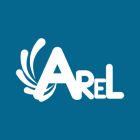
Article Tags:
-
Refugee
-
Classrooms
-
Education
-
Problems
